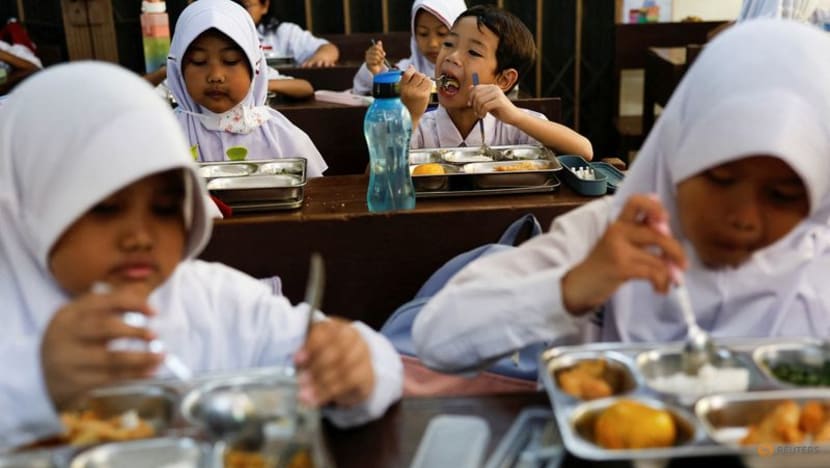Commentary: The real costs of Indonesia’s free school lunch programme can't be ignored
President Prabowo Subianto’s universal free meals programme is well-intentioned, but it would be more effective if done in coordination with other complementary programmes, say these experts.

FILE PHOTO: Students eat meals from the free nutritious meals program at a school in Jakarta, Indonesia, January 6, 2025. REUTERS/Willy Kurniawan/File Photo
SINGAPORE: Indonesian President Prabowo Subianto has launched a universal free school lunch programme targeting 83 million children with an initial 17 million target by the end of 2025. This is primarily aimed at improving the nutritional status of Indonesian children, including stunting.
There are three issues associated with the programme that may render it unsustainable and ineffective: What is on the plate, the target recipients and the fiscal sustainability.
Indonesian children suffer from the “triple burden of malnutrition” to various extents: Undernutrition (stunting, wasting and underweight), overnutrition (overweight and obesity), and micronutrient deficiency (lack of essential multivitamins and nutrients).
However, as socio-economic conditions improve, the prevalence of undernutrition will usually fall, followed by an associated rise in overnutrition. This applies to Indonesia and many other developing countries. In other words, most Indonesian children may be eating enough but not well.
One in five primary-school children (19.7 per cent) was either overweight or obese, according to the Indonesian Health Survey 2023 Report. This is nearly double the share of underweight children (11 per cent). Stunting (18.7 per cent) and micronutrient deficiency (for example, anaemia at 16.3 per cent) were also more prevalent than being underweight.
WHEN EATING ENOUGH DOES NOT MEAN EATING WELL
There are three issues related to the universal free school meal programme worth highlighting.
First, it is important to note what is on the plate. Without proper standardisation of food being served to the children including food safety standards, the programme risks being ineffective and harmful to children.
For example, evidence shows that providing calorie-and-protein-rich food without critical micronutrients may improve weight but not height, thus promoting obesity. In other words, Indonesian children need micronutrient-rich food and not only calorie-and-protein-rich food.
The government’s initial plan to include milk as part of the free school lunch was misguided. Since milk is not available in all regions, the provision of milk is no longer compulsory. Indonesian children, like their Asian counterparts, have high lactose intolerance due to possible genetic or cultural reasons. In 2017, the government revised Indonesia’s nutrition campaign so that milk was not considered necessary anymore to complete nutritional needs.
The government plans to have domestic cattle breeders import 1.3 million breeding cows, to provide milk and meat for the lunch programme. This is costly and will also cause environmental damage.
Potential food waste from the programme is also huge and will exacerbate Indonesia’s status as the world’s second-largest country in producing food loss and waste per capita.
Second, the programme needs to consider its target recipients. With various nutritional problems among Indonesian children – some may be underweight, stunted or obese while being micronutrient deficient – there is a weak case for a universal, one-fits-all type of intervention.
A study in Chile on a supplemental feeding programme for pre-school children shows that unless the status of being underweight is universal, a targeted intervention is needed to prevent obesity.
Third, the government has to be mindful of the programme’s fiscal sustainability.
The National Nutrition Agency has already acknowledged the lack of funding amid struggles to cover ballooning costs. It has slashed the cost per lunch box by a third to around 10,000 rupiah (US$0.60). This year’s phased rollout from three million to 17.5 million recipients will cost 71 trillion rupiah (US$4.3 billion). If expanded to 83 million children as originally planned, it is estimated to cost US$28 billion.
It is questionable how fiscally sustainable the programme is as this may mean higher taxes for the already faltering middle class. It could also mean that the government would have to “rob Peter to pay Paul”: That is, take money from the budgets of other government programmes.
In this context, subsidising the meals of children from rich households seems inappropriate.
NOT A PANACEA
Ensuring good governance (especially food safety) would be essential to preventing the programme from being the “pebble in the shoe” as it involves thousands of caterers and other service providers in transportation and logistics.
It is also important to clarify the roles of a plethora of government agencies involved including the National Nutrition Agency, the Coordinating Ministry of Food Affairs, the Ministry of Health, as well as the local governments. The prominent use of the military and the centralised kitchen system may also crowd out local micro and small enterprises, which the government had intended to support.
The government’s free school meal programme is not a panacea for addressing the triple burden of nutritional issues among Indonesian children.
It is also not the only programme that could help address the issue. For example, stunting, which is already being addressed under the National Strategy to Accelerate Stunting Prevention (Stranas), is an irreversible malnutrition problem after the age of two years old. It is caused by factors beyond food availability. Free school meal programmes can help reduce the long-term effects of stunting, but it is not a programme to reduce stunting.
Indonesia’s free school lunch programme would be more effective if it is done in coordination with other complementary programmes. These include behavioural change and communication to improve dietary practices and measuring children’s nutritional status at school at both the baseline and throughout the programme.
Other needed complementary programmes include physical activities, deworming programmes and food fortification.
Besides more targeted interventions, there are alternative programmes to address Indonesian children’s nutritional status that might be easier to implement and more cost-efficient. This includes targeted subsidies to full-day preschool, which has been proven to positively affect children’s development including anthropometric status.
In short, there is no such thing as a free lunch. The government should be mindful of the potential consequences and policy gaps.
Maria Monica Wihardja is a visiting fellow and co-coordinator of the Media, Technology and Society Programme at ISEAS - Yusof Ishak Institute, and also adjunct assistant professor at the National University of Singapore. In 2017, she worked at the Executive Office of the President of the Republic of Indonesia as a senior advisor to the Deputy Chief Staff in charge of strategic economic issues, where she oversaw the food policy reforms and stunting prevention agenda. Arianto Patunru is a fellow of ANU Indonesia Project, Arndt-Corden Department of Economics, Australian National University and the chairman of Center of Indonesian Policy Studies. This commentary first appeared on the ISEAS-Yusof Ishak Institute's blog, Fulcrum.



















